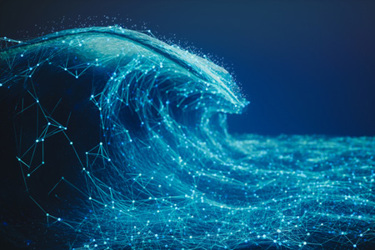AI's Water Problem Is Worse Than You Think (But It Doesn't Have To Be)
By Christian Bonawandt

There’s little doubt that AI is quickly becoming a powerful if not essential tool in our society. It’s being used to help boost efficiencies and productivity in myriad ways — including for the research portion of this article. However, this productivity doesn’t come for free. One of the biggest costs associated with AI is its demand for water.
Even before the AI boom, water industry professionals worried about the massive amounts of water data centers required for cooling and how that demand impacts water scarcity issues worldwide. The rise of AI is now making this worse. But the problem goes well beyond just consuming water for cooling. Challenges associated with wastewater, chip manufacturing, and even efforts to produce cleaner energy are all exacerbating AI’s water consumption problem.
Cooling Costs
While all data centers require water for use in chillers, coolers, and cooling towers, AI systems require far more. For example, a single Google search is estimated to require half a milliliter of water in energy, while ChatGPT consumes between 10 to 100 milliliters for every prompt. Even worse, just training AI systems to be able to handle such prompts requires enormous amounts of water. Training GPT-3 in Microsoft’s U.S. data centers, for instance, is estimated to consume a total of 1.4 million gallons (5.4 million liters), including about 185,000 gallons (700,000 liters) of on-site consumption. This is only expected to get worse as the application of AI intensifies. A study from Cornell University finds that global AI demand is projected to account for 1.1 to 1.74 trillion gallons of water withdrawal by 2027, which is more than four times Denmark’s water withdrawal and approximately half of the UK’s. The study also estimates the total annual on-site water consumption by U.S. data centers will be between 40 and 74 billion gallons by 2028.
The Silicon Surcharge
Like many new technologies, AI depends on semiconductors for microchips, integrated circuits, and diodes. The semiconductor manufacturing process relies on ultrapure water (UPW) to rinse impurities from silicon chips. UPW is thousands of times cleaner than standard drinking water, yet creating just 1,000 gallons of it consumes 1,400 to 1,600 gallons of drinking water. All told, an average chip manufacturing facility can use 10 million gallons of ultrapure water per day, which is equivalent to 33,000 U.S. households. A medium-sized semiconductor factory consumes as much water as a city of 58,000 inhabitants.
Wastewater Woes
The impact of AI doesn’t end with consumption. The cooling technologies used in data centers are producing wastewater contaminated with dust, chemicals, and minerals. Chip manufacturing also generates wastewater that contains challenging pollutants, including heavy metals. This wastewater is toxic to the environment and can be difficult for municipal wastewater plants to treat and remove.
Further down the supply chain, mining precious metals and rare earth elements (such as silicon, germanium, gallium, boron, and phosphorus) required for semiconductors and other AI hardware also consumes and pollutes water resources. The extraction process alone has a significant environmental impact and contributes to water pollution.
Solutions For Sustainability
Although AI’s impact on the water industry is far from positive, there is ongoing progress to improve it. For example, an increasing number of data centers and chip makers are treating and reusing their water, only drawing to replenish losses. In addition, many are using recycled municipal wastewater rather than drinking water for cooling. Technology company Intel, for example, has partnered with the city of Chandler, AZ, to create a reclaimed water facility to supplement groundwater supplies for its new chip factories in Phoenix.
Water isn’t the only resource AI greedily consumes. In an effort to reduce their strain on electrical grids and improve their carbon footprint, many AI data centers are turning to green hydrogen as a power source. Green hydrogen is formed from water, and while that may seem like it adds to AI’s demand, current data shows the opposite. One study estimates that each kilowatt-hour generated from green hydrogen requires about half as much water as coal or nuclear power sources.
Of course, it’s important not to forget the many ways AI can support water conservation efforts. AI tools are being implemented to improve water management and increase water efficiency in agriculture and wastewater treatment, as well as leak detection. The bottom line is that, while AI presents a serious water problem, the means exist to minimize it.
Addressing AI's escalating water footprint, particularly in data center cooling and chip manufacturing, is crucial for sustainable technological advancement. While the industry is making strides in water recycling and efficiency, the projected increase in AI demand necessitates an urgent, concerted effort to mitigate its environmental impact. Ultimately, balancing AI's transformative potential with responsible water stewardship will define its long-term viability and benefit to society.
 Christian Bonawandt is an industrial content writer for Water Online. He has been writing about B2B technology and industrial processes for 24 years.
Christian Bonawandt is an industrial content writer for Water Online. He has been writing about B2B technology and industrial processes for 24 years.
